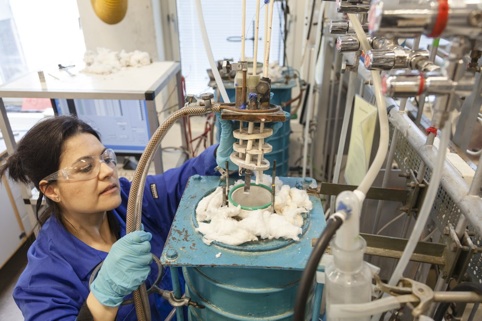Rare earth metals, such as neodynium and dysporsium, are vital ingredients of the powerful permanent magnets used in the types of electric motor used in electric cars and in the dynamos in wind turbines; they are also used in the electronics of mobile phones and in LEDs. Although quite abundant in the Earth’s crust, they tend to occur at low concentrations apart from in a few locations.

One of these locations is China, which produces 95 per cent of the world’s rare earth metal supply and is the only country that supplies the commercial market. Recently, it has begun to limit exports, and there are concerns that this could lead to bottlenecks as renewable energy and electric vehicle demand rises.
The SINTEF project is one of several devoted to recovering rare earth metals, and uses technology from aluminium smelting — an industry that is well known in Norway; one of the world’s biggest aluminium producers, Norsk Hydro, is Norwegian. Aluminium is extracted from its ore using high-temperature electrolysis, and this technology, the SINTEF team believes, can also be used to recover rare earth metals from permanent magnets.
Magnets contain three rare earths: neodynium, dysporsium and praesodynium. SINTEF researcher Ana María Martínez has been working on high-temperature electrolysis to recover the metals from discarded magnets and from magnet manufacturing scrap. ‘The results of our recycling experiments using laboratory-scale electrolysis are promising,’ she said, ‘but the process is still too slow.’
Scrap from magnet manufacture is one of the most promising sources of material for recycling, because it is not itself magnetic; transport of permanent magnets over long distances is heavily regulated. Moreover, Martínez said, scrap is currently far more abundant. ‘It will be a while before enough electric vehicles have been scrapped to make their motors into a significant source of rare earth metals for recycling,’ she pointed out. ‘However, there are probably already large volumes of magnetic alloys available in scrap from manufacturers. For some purposes, this is re-smelted in the production furnaces, but the resulting alloys are left with properties that make them unsuitable for high-quality magnets.’
Martínez stresses that the research is at an early stage. ‘A lot of research still needs to be done, because there are many aspects that need to be optimised before we can be certain of reaching our goals,’ she said. ‘But if we succeed, we will have a method that is much simpler than existing processes that are based on strong acids.’




Red Bull makes hydrogen fuel cell play with AVL
Formula 1 is an anachronistic anomaly where its only cutting edge is in engine development. The rules prohibit any real innovation and there would be...